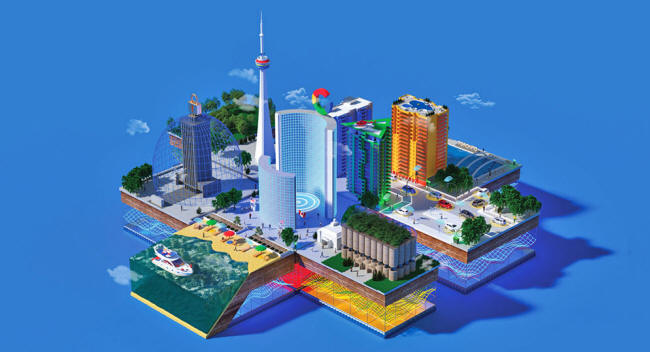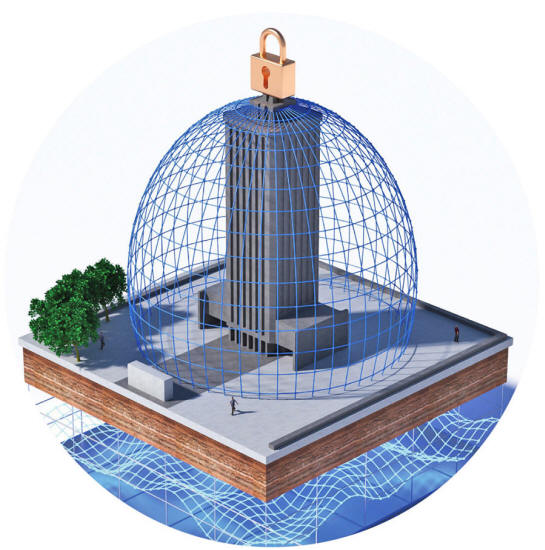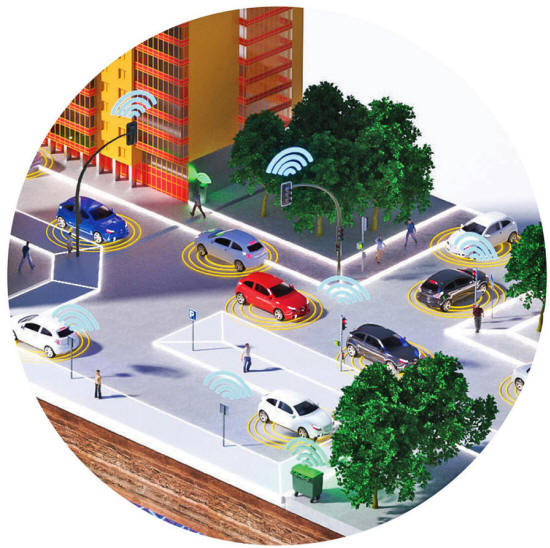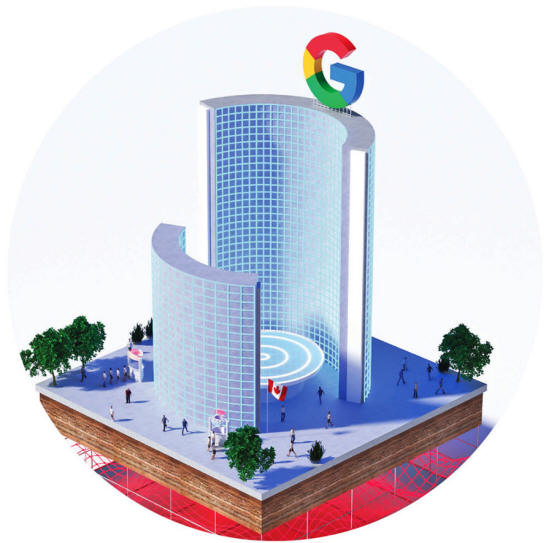|
from
Politico Website with Google's logo looming over the skyline.
Illustration by Ben Fearnley
Google is Building a City of the Future in Toronto.
Would Anyone
Want to Live There? - or a peek into the Orwellian metropolis that knows everything you did last night...
TORONTO
Even with a chilly mid-May breeze blowing off Lake Ontario, this city's western waterfront approaches idyllic.
The lake laps up against the boardwalk, people sit in colorful Adirondack chairs and footfalls of pedestrians compete with the cry of gulls. But walk east, and the scene quickly changes.
Cut off from gleaming downtown Toronto by the Gardiner Expressway, the city trails off into a dusty landscape of rock-strewn parking lots and heaps of construction materials.
Toronto's eastern waterfront is bleak enough that Guillermo del Toro's gothic film The Shape of Water used it as a plausible stand-in for Baltimore circa 1962.
Says Adam Vaughan, a former journalist who represents this district in Canada's Parliament,
That was before Google.
The idea is to re-imagine Toronto's derelict waterfront as,
The neighborhood, called
Quayside, would leapfrog the usual
slow walk of gentrification to build an entire zone, all at once, as
a "smart city," a sensor-enabled, highly wired metropolis that can
run itself.
Still in its early days, the partnership has left people curious but wary.
Google...? What does a
tech company know about running a real live city?
PayPal co-founder
Peter Thiel helped seed the "seasteading" movement to create
offshore libertarian paradises; the tech incubator
YCombinator is
currently running a public-policy experiment in Oakland, California,
giving residents a guaranteed monthly stipend to see how it might
improve their quality of life.
But the real dream, a place whose constant data flow lets it optimize services constantly, requires something different, a ground-up project not only woven through with sensors and Wi-Fi, but shaped around waves of innovation still to come, like self-driving cars.
Thanks to a host of technological advances, that's practical now in a way it never has been before.
Mass-produced sensors now
cost less than a dollar apiece, even for hobbyists; high-speed
broadband and cheap cloud computing mean that a city can collect and
analyze reams of data in real time.
Apps would tell residents when the Adirondack chairs on the waterfront are open, and neighbors would crowdsource approvals for block-party permits, giving a thumbs-up or thumbs-down based on the noise the gathering was expected to produce.
Traffic signals could auto-calibrate to ease pedestrian congestion during public events, or to ensure a smooth rush hour.
The data from such systems would feed back into the city, which would constantly learn, optimizing its own operations from month to month, year to year.
Sidewalk promises,
The idea is to re-imagine Toronto's derelict waterfront as,
But with it comes a host of new questions, points out Vaughan, the Toronto MP. Day to day, a truly smart city runs on data and algorithms rather than civic decisions made by humans.
So,
Some of the worries are abstract and long-term, such as whether it's possible to have too much order, stripping cities of their energy and serendipity.
Others are landing in the laps of city leaders right now:
Here's a short series of
primers on the questions raised by projects in Toronto and
elsewhere.
But there are already hints of darker potential.
The ruler of Dubai says his plan to collect data on citizens is intended to "make Dubai the happiest city on earth," but skeptics of the United Arab Emirates' human rights record aren't so sure what will happen when all its cellphone-obsessed residents are being tracked by an authoritarian state.
Fans of what's become known as Sidewalk Toronto say there are few better places to have this conversation than Canada, a Western democracy that takes seriously debates over informational privacy and data ownership - and is known for managing to stay polite while discussing even hot-button civic issues.
Hitching up with tech companies that are flush with both cash and grand visions might be cities' best chance to leap into the future, or at least to turbocharge their lagging districts.
But some aren't so sure cities will get the better end of the deal.
Google is already buying up chunks of the Bay Area and New York; its power and public appeal could easily overwhelm cash-strapped local governments even before it becomes the repository for all that citizen data.
Some urbanists and
good-government advocates fret that going down the aisle with big
corporations might be a short-term salvation that, generations from
now, will have set cities on the wrong path.
He is a champion of the idea that cities should engage in careful "digital master planning," thinking through for themselves the role of technology in urban life.
He's not shy about touting the importance of the movement, especially for sustainable living - in a 2013 book, Smart Cities: Big Data, Civic Hackers, and the Quest for a New Utopia, he wrote:
...but also warns that cities are in danger of blindly and haphazardly embracing innovations presented to them by industry.
protected by a spherical network with a copper-colored lock. Illustration by Ben Fearnley
He wonders, though, whether Quayside is ambitious enough - whether its accumulation of existing technology really amounts to the kind of breakthrough cities need.
Modern cities, with money and an educated population, should be the labs for big new ideas about living, and Sidewalk is their best shot right now.
Other observers counter that Sidewalk is aiming high - that aggregating all that technology in one place could be its own kind of breakthrough.
One analogy that Sidewalk itself uses is to ancient Rome:
Modern cities thrive on information, but none has built itself around data infrastructure in a similar way; connecting a bevy of smaller-scale innovations through a common networked digital platform could be a hugely powerful innovation in itself.
Sidewalk's former chief operating officer, borrowing a term from the software world, calls it a chance to "re-imagine the full stack."
Bruce Katz, co-author of the 2018 book The New Localism and founder of the Brookings Institution's Metropolitan Policy Program, says,
Google is not the first company to try reimagining a city.
Epcot Center, the Florida theme park, has its roots as a real city-building idea.
The name is an acronym for the Experimental Prototype Community of Tomorrow, and it began as Walt Disney's vision of a carefully engineered urban paradise of the 1960s, one that would,
No less than the New York "master builder" Robert Moses called Disney's vision for Epcot "overwhelming."
But it wouldn't come to
pass. Disney died of lung cancer shortly after shooting that film,
and Disney, the company, balked at being in the city-building
business. It ended up as a theme park.
And today's "new
technologies" are more seamlessly integrated into people's daily
lives than even Disney might have imagined. The corporations behind
the technologies, like Google, have the power and reach to envision
changes on a scale far beyond a theme park.
So, who owns all the
data? Whose laws apply?
Doctoroff was available:
Doctoroff formed Sidewalk Labs and headquartered it in Hudson Yards, a brand-new neighborhood on Manhattan's once-seedy far west side that took root amid what was left over from a failed 2012 Olympic bid that Doctoroff had helmed. (There was supposed to be a stadium in that spot.)
And the company started looking for land.
Appealingly, it was on the waterfront, and the city was ready for it to change.
It even had a new government structure in place to oversee the property, an entity called Waterfront Toronto, made up of three layers of government - city, provincial and national - which itself is the product of a failed Olympic bid. Its job was to make something happen.
That so much of government was already on board with the waterfront project was hugely appealing to Sidewalk.
Canada's youthful prime minister,
Justin Trudeau, was invested in the idea; he had already been
talking to Google's leadership about the possibility of a second
Silicon Valley north of the border.
The local tech sector was booming. In fact, the very artificial intelligence that powers post-search Google was in large part pioneered at the University of Toronto.
Toronto, whose population is half foreign-born, is a magnet for immigrants, and "technology is powered by immigrants," said Schmidt.
Doctoroff would later testify that Sidewalk had scoured the world, and,
Waterfront Toronto issued a request for proposals for the site, with a tight turnaround of six weeks.
Sidewalk scrambled and generated a plan hundreds of pages long, complete with quirky line drawings of local features, that offered a sweeping vision of a neighborhood built from the ground up - actually, from below the ground up - to be a home for innovation. It got the contract.
At a news conference last October to announce the partnership, Trudeau argued that Torontonians had little choice but to get engaged in the debate about what could happen on the waterfront:
Waterfront Toronto has declined to make the exact terms of its deal with Sidewalk public, so no one on the outside knows exactly what the city has promised Google, or vice versa.
But the basic idea is for Sidewalk to go on a yearlong local listening tour, brainstorming along the way for a master development plan for the dozen-acre slice of land.
If the plan is approved
by Waterfront Toronto's board, that group and Sidewalk will serve as
co-master developers, with the latter in charge of funding and
"innovation" - how to design streets to handle self-driving cars, or
how to build underground utility channels serving as conduits for
city services that haven't even been dreamt up yet.
Known as "Rit," Aggarwala - like Trudeau, a spirited 46 - sports rimless glasses and close-cropped hair, and is something of the brains behind the Sidewalk Labs operation.
Aggarwala, too, served in New York City government, as head of its sustainability plan. (Perhaps the flagship initiative of that plan, congestion pricing to ease traffic in the heart of the city, did not come to pass.)
Aggarwala, who along the way picked up a master's degree in Canadian history, with a thesis called "American Trade and Urban Dominance in Upper Canada, 1830-1850," said by phone that Quayside is,
on a street corner - including cars aware of their surroundings. Illustration by Ben Fearnley
Part of the founding team at Sidewalk Labs, Aggarwala made a study of neighborhoods, even whole cities, designed from scratch.
One was the original Epcot, which he credits as a visionary project that tried to ambitiously "move the needle" - in part by trying to conquer the sometimes inhospitably hot and humid environment of inland Florida with a vast downtown dome.
With cars banished below ground, humans would travel around instead via never-stopping electric-powered trollies called People Movers.
And it wasn't seen as a static achievement:
Even a highly planned
community isn't done just because it's opened its doors.
She considers herself a "smart-cities nerd" but says that the "smart city" branding that's attracted so much attention is more Google's than Toronto's.
The city itself was mainly interested in the promise of solid economic development and a quick timetable.
Sidewalk's pitch had a number of compelling points, she says:
Appealingly, Google itself promised to anchor the project, moving its Canadian headquarters from Toronto's financial district down to a to-be-determined spot on the eastern waterfront.
But most attractive, she says, is that Sidewalk's proposal was soup to nuts.
It was not simply a smart-cities play; it considered everything from sustainability to housing.
The relationship between government and Sidewalk remains a work in progress, and some critics worry that handing over too much control to a private company will set the wrong precedent.
By definition, the autonomy of a smart city means taking some hands-on day-to-day decision-making away from elected officials and civil servants.
And when the complex algorithms and data-collection decisions driving those city operations are in the hands of one company, that can raise worries that too much power over our civic lives is being handed over to private interests.
This is the first, and maybe broadest, point of concern that has started to bubble up about smart cities, not just in Toronto.
Using data to organize
and optimize, Google's expertise since its early days as a search
company, makes a lot of sense in the online world, the argument
goes, but is a far different tool when it's applied to the chaos
that makes cities cities.
The for-profit tech sector, shot through with libertarian disdain for government and the build-and-flip ethos of the startup world, isn't well-matched for the kind of work it takes to run a city:
The most fundamental flaw she sees when it comes to Silicon Valley's city-building ambitions is the gap between what data can and can't do.
The beauty of urban life is what happens organically, argues Arieff.
"They really do believe in their heart and soul that it's all algorithmically controllable," says urbanist Allison Arieff, "and it's just not."
At the street level, another worry is that Sidewalk could exacerbate a trend in urban innovation toward intentionally cutting down on actual human interactions.
If even the beach chairs are wired and reservable, do neighbors ever have to meet?
An example of what concerns urbanists is the "meatless and wheatless" eatery near Google's current Toronto headquarters, at which there are separate counter locations for picking up orders made via two competing Toronto-based food apps.
Local workers breeze in, flash a phone, grab their prepackaged almond lime bowls and breeze out.
It's impossibly efficient, and appealing to young tech workers
who never have to take out their earbuds, but it also eliminates the
most basic kind of human interaction at the heart of city living.
He considers it a caricature:
Urbanists like Arieff, or the famed author and activist Jane Jacobs, value the fabric of cities for its density, life and serendipity.
Aggarwala sees data as a way to protect and improve that experience, not replace it. Traffic signals already in place in many cities are timed to make it so no driver is kept waiting at a red light on an empty street in the middle of the night - making cities both safer and smoother-running.
Expanding that technology could do the same for the pedestrians that urbanists love.
Today's technology, Aggarwala says, can,
Sidewalk's idea for snow-melting sidewalks would let residents enjoy more of the city for more of the year.
Self-driving cars, integrated properly into the streetscape, could make it more humane.
Just about all players involved believe that if Sidewalk can be successful at Quayside, it has a shot at the adjoining 800-acre Port Lands, a swath of problem space big enough to become home to a dozen new neighborhoods in a growing metropolis.
Townsend, the consultant, says of the Port Lands:
A project on that scale - a dozen neighborhoods in one of the highest-profile cities in North America - could set the tone for urban development all over the world from here on out.
What sort of tone that will be, though, is the big question, and one area in which there are the fewest answers is the simple matter of information.
topped by a large Google logo and with a Canadian flag waving out in front. Illustration by Ben Fearnley
That dynamic quickly turns the future of the smart city from a technological question to a fundamentally civic one. Heaps of data are already piling up in cities around the world, with very little agreement on the best way to handle all that information.
Toronto could well be a
test bed, a suggestion Doctoroff has made himself.
Whose "order" will it be? That's what worries people.
Take Dubai, says Ann Cavoukian, a civic-privacy specialist who is consulting for Sidewalk on the Toronto project.
That city in the United Arab Emirates set out in 2014 to become what it called the world's smartest city.
The director of the effort has said,
Cavoukian served three terms as Ontario's privacy commissioner and is now Sidewalk Labs' lead outside privacy consultant on the Toronto project.
She is known for having developed a concept called "privacy by design," which in its simplest form argues that privacy must be baked into everything from software to cities from the very beginning.
In an ideal privacy regime, the system can't track individuals; any personally identifiable information on people living in or moving through Quayside would be scrubbed right at the sensor.
So a sidewalk, for example, could track the flow of pedestrians all day without ever knowing who they were.
Aggarwala says that over time Sidewalk has come to appreciate "how deeply different" the Canadian view of privacy is compared with that in the United States.
Canadians tend to see privacy as a fundamental human right; Americans have historically been more willing to see it as something that should be protected, with abuses punished after the fact, but which can be traded away in exchange for some benefits, like free Gmail.
Google makes its billions in large part by collecting data on its users and slicing and dicing it for the benefit of advertisers. Sidewalk has already stipulated that data collected in Quayside won't be used for advertising purposes.
Says Cavoukian,
But even if, as Cavoukian contends, stripping personally identifiable data at the sensor in most cases largely addresses privacy concerns, other worries remain.
Some privacy advocates worry about the idea of collective privacy, or the idea that data can be used to know things about communities they would rather not have everyone know, like tracking residents' movements to create a profile of the overall rhythms of a neighborhood, or even analyzing sewage for signs of concentrated drug use.
That issue hasn't come up for discussion in Quayside, Cavoukian says.
(Asked about it, Aggarwala says that community-level data can be hugely useful, pointing to the value of the Canadian and U.S. censuses, which are largely uncontroversial data-collection efforts.)
And then there's the idea of what sort of entity makes the calls on how the data can be used.
Waterfront Toronto's CEO
has floated the notion of a "data trust," a third party that would
make decisions about proper uses of the information collected at
Quayside.
The information economy depends on highly networked, decentralized systems that share data across companies, devices and borders.
This data sharing has lately become a political issue, in part because the United States' handling of data has been the subject of global suspicion since the revelations of Edward Snowden.
Some countries, including,
...reacted to evidence of U.S. companies' sharing of user data with the U.S. government by demanding so-called data localization or data sovereignty - requiring that information that affects a country's people must be physically housed inside its borders.
The United States had been making some headway advocating for open digital borders in trade negotiations, but President Donald Trump's withdrawal from some of those agreements, such as the Trans-Pacific Partnership, means, says Daniel Castro, director of the Center for Data Innovation at the Information Technology and Innovation Foundation,
Canadians see privacy as
a fundamental human right; Americans see it as something that should
be protected, with abuses punished after the fact.
Waterfront Toronto's Verner, though, isn't so sure that's possible or even wise.
As they have worked through the planning process for Quayside, she says, they have come across instances where it makes sense to let the data migrate, such as if the expert best able to solve an issue with a sensor in Toronto is located in, say, New York.
Or if a company providing a service riding on top of the Sidewalk-powered digital layer is housed on the other side of the world.
Keeping all the data strictly in Canada, Verner says,
As the data debate makes clear, there's much here that isn't going to be in Toronto's hands, or even Sidewalk's, and it's not clear that the city has worked out that issue yet.
Townsend, the former Sidewalk consultant, jabs that thus far in Toronto, Sidewalk has spent more time discussing garbage innovation than data management.
Sidewalk officials say they agree about the stakes:
...but say it's still a work in progress.
Verner argues that the conversations will flow more freely once there are specific technologies to which to react. Cavoukian, for her part, holds that Sidewalk's only failing thus far is not pushing back aggressively enough against complaints about the company's seriousness when it comes to privacy.
The company is giving
every sign so far, she says, of making the correct moves.
And as tech companies grow more interested in building cities of the future, some urban-development experts are drawing attention to what they say is a power imbalance.
Cities can find themselves at the mercy of companies pitching everything from shiny new apps to, in the case of Amazon, a shiny second headquarters.
Sidewalk says it appreciates the balance and takes pride in not nudging cities for handouts.
Even Townsend, who can be critical of Sidewalk's work on Toronto, says it compares well on that point to Amazon, whose high-profile headquarters search has seen cities competing to offer the giant the sweetest deal.
They should be careful what they wish for, he says:
But Simone Brody argues that even where companies attempt to carefully navigate that power imbalance, it exists.
The cold hard fact is that while cities have struggled, Silicon Valley has companies that have produced astonishingly large heaps of cash. And in many cases, they need places to put it.
One way of looking at the Sidewalk Toronto project, argues Townsend, is as a bid for a hugely valuable piece of real estate dressed up with a bit of what he calls "smartwashing."
Google has been in the market for attractive properties in knowledge centers lately. It recently bought Manhattan's Chelsea Market for a whopping $2.4 billion.
For companies with
overflowing coffers, cities are an attractive place to put that
cash.
But officials might soon find that those companies end up owning not just slices of real estate but also, as they take on more local responsibility, huge chunks of information about how cities themselves function.
Sidewalk has pointedly engaged in a series of public meetings and online consultations meant to give Torontonians a voice in the process.
An on-site pavilion is meant to open up in Quayside in late summer.
Some in the urban affairs world see that back-and-forth as a huge improvement over how developers tend to work, and give Sidewalk credit for rethinking the often hopelessly adversarial process that often marks real-estate projects.
|





